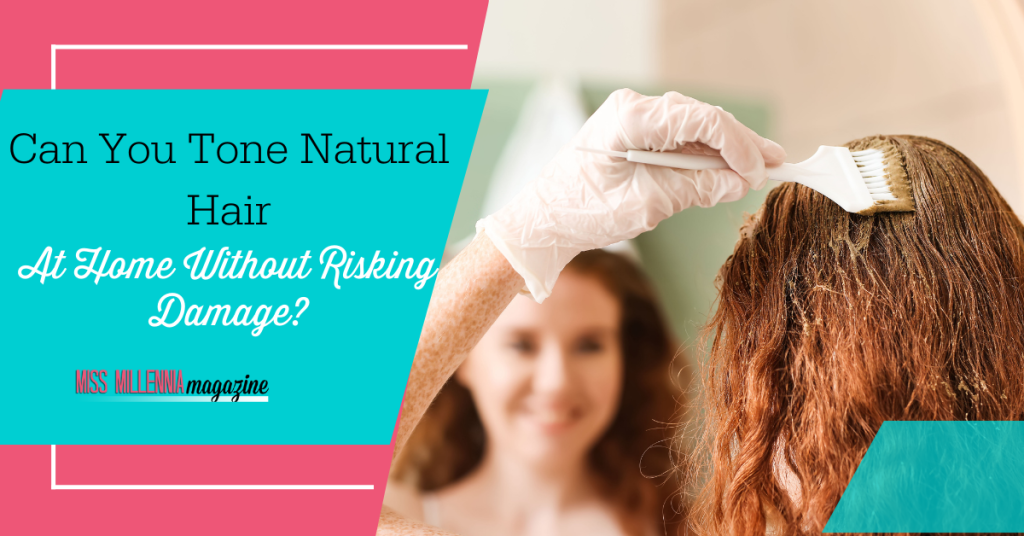Can You Tone Natural Hair At Home Without Risking Damage?

Starting a journey to transform your hair color is an exciting and personal decision that allows individuals to express their creativity and style. However, the first step to achieving this change is to be responsible for maintaining the overall health and integrity of natural hair. The best way to be practical is to tone your natural hair at home, which can affordably give a vibrant transformation.
Still, it always comes with careful consideration and awareness to prevent potential damage. This comprehensive guide will discuss the process of safely toning natural hair at home, providing detailed steps and insights to ensure the best results without compromising the health of your precious crowning glory.
Understanding Hair Toning
Hair toning is a strategic process designed to neutralize and counteract any unwanted undertones that may arise naturally or from previous color treatments; it is doing a color correction for the rest of your hair. Undertones like brassy hair or yellow hues can be effectively addressed through toning, demanding a thorough understanding of the products and techniques involved to achieve optimal results without causing harm to the hair.
Hair toners are available in an applicator bottle, which is over-the-counter at the nearby grocery store, pharmacy, or salon. However, be sure to check the ingredients carefully as well as the directions for use to be on the safe side.
Assessing Your Hair
Before going deeper into the toning process, a meticulous assessment of your hair is crucial, regardless of whether you have gray or brunette hair. This involves evaluating various factors such as texture, porosity, and existing color. Understanding the specific undertones you wish to address is equally crucial. This comprehensive evaluation forms the foundation for choosing the right balance of toning products and making the entire process match the unique characteristics of your hair.
Choosing the Right Toning Product
Selecting the appropriate toner must be a priority in achieving the desired results without causing any harm to your hair. Extensive research becomes a standard operating procedure t to identify a toner that aligns with your hair type and color goals. For those seeking a much milder approach, opting for semi-permanent or demi-permanent toners is recommended, minimizing potential damage while achieving vibrant and long-lasting results.
Gathering Supplies
Starting the toning process requires in-depth experience, beginning with gathering all necessary supplies. Essential items such as gloves, an applicator brush, and a mixing bowl are not just essentials but are vital for an efficient and controlled application.
Ensuring you have these supplies on hand sets the stage for a smooth process, minimizing the risk of errors during application. If you want to avoid unwanted tones, opt for products that are already tried and tested because they will keep you worry-free while using them.
Buy this Hair Dying Kit on Amazon.
Protecting Your Hair
Prioritizing the health of your hair is non-negotiable when trying to do any coloring process. Before toning, applying a deep conditioner becomes the initial step to nourish and strengthen your hair. Additionally, creating a protective barrier using natural oils like coconut oil helps shield your hair from potential damage during the toning process. It will also act as a moisturizer to ensure you will not have dry hair before and after the dye job.
Protect your hair and buy a coconut oil conditioner on Amazon.
Preparing the Toner
Following precise instructions is crucial when preparing the toner. This includes adhering to recommended mixing ratios and application guidelines to ensure the toner achieves the desired shade without compromising the integrity of your hair. Attention to detail during this step is the best trait to have when it comes to this. Be sure to know what kind of hair you possess because products may vary depending on your hair type, especially if you want the right shade.
Application Techniques
Understanding the ins and outs of application techniques is critical to achieving a natural-looking tone. Distinguishing between root and full-head application and employing tips for even distribution and saturation contribute to uniform color results and prevent undesirable patchiness. Once you have mastered the various application techniques, you can minimize the frequency of your salon appointments, thus saving you a lot of money in the long run. Plus, you can customize your techniques to your liking as long as they are safe.
Timing and Monitoring
Thoroughly rinsing the hair with cool water after the designated toning period is crucial to lock in the color. Followed by a color-safe, sulfate-free shampoo and conditioner, this aftercare routine maintains the longevity of the newly toned hair, contributing to vibrant and healthy-looking locks. For darker shades, expect you’ll have to spend a longer time applying and monitoring to achieve a much darker hair color.
Buy Sulfate Free Shampoo on Amazon.
Rinsing and Aftercare
After applying your chosen hair color, rinsing it thoroughly with cool water is crucial. Cool water helps seal the hair cuticles, locking them in the shade and preventing premature fading. Avoiding hot water is emphasized, as it can open the cuticle and diminish the vibrancy of your freshly colored hair.
Some people apply apple cider vinegar and other natural ingredients to their hair. It makes their hair supple and more natural even after extensive hair treatments.
However, this should not apply to everyone because everyone has their corresponding hair type. Some may respond well to natural hair care routines, while others might be susceptible to acidity, even if it is from a natural source. Well, it is a good idea to ask for the advice of a hair professional before trying things for the first time.
Follow Up with a Color-Safe, Sulfate-Free Shampoo and Conditioner
Choosing the right shampoo and conditioner is essential in maintaining the longevity and vibrancy of your newly colored hair. Opt for a color-safe, sulfate-free shampoo and conditioner specifically formulated to protect and nourish color-treated hair. Sulfates can strip away the color and essential oils from your hair, leading to premature fading and dryness.
Gently massage the color-safe products into your hair, focusing on the roots and tips, and rinse thoroughly with lukewarm water. This routine will help preserve the richness of your color and keep your hair looking vibrant and healthy. The good news is many products such as these are affordable and effective for a wide range of hair strands. Some are natural toners, while others are mostly made with artificial ingredients.
Maintaining Toned Hair
Extending the life of your toner involves adding color-protecting products, such as purple shampoo and blue toner, into your routine. You can apply the shampoo to your wet hair every time you bathe. Minimizing heat styling is recommended to prevent accelerated fading, ensuring the vibrancy of your toned hair lasts longer.
Common Mistakes to Avoid
Awareness of potential mistakes is crucial to a successful toning process. Over-toning, selecting the wrong shade, or engaging in excessive toning frequency may lead to undesirable outcomes. Also, using hair products for your aftercare routine without following the instructions can be disastrous. For example, you apply a hair cream to your dehydrated hair, but you’ll need to have damp hair slightly before using it, which could lead to severe consequences.
Not only that, but you have to be aware of various hair products that have potent ingredients, such as ammonia-based toners. Do not overapply it.
Patch Testing
Performing a patch test before applying the toner is a prudent step to identify any potential allergies or adverse reactions. This ensures the safety of both the skin and the hair during the toning process. Homemade tonners are gentle, but allergies are person-specific, which is why even a professional hair colorist will care to ask if their customer has an allergy to avoid undesirable scenarios happening after applying the toner.
When to Seek Professional Help
For complex color corrections or significant changes, seeking the expertise of a professional stylist is advisable. Their knowledge and experience can help achieve salon-quality results without compromising the hair’s health. They also use a tried and tested specific salon toner that they know can give a lot of benefits to their customers.
Conclusion
Toning natural hair at home is an attainable and thrilling process when done with meticulous care and attention. Being open to change while prioritizing the health of your hair allows you to confidently transform it without risking damage. With careful consideration of each step and a commitment to hair health, achieving your hair’s desired tone is possible and a rewarding experience for everyone, combined with the proper toner and perseverance.











